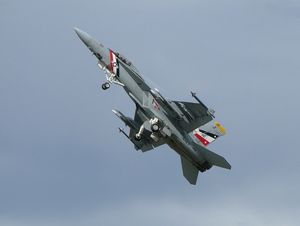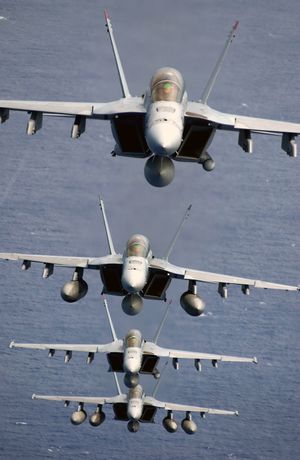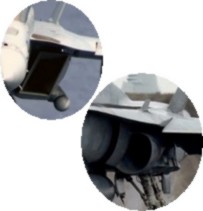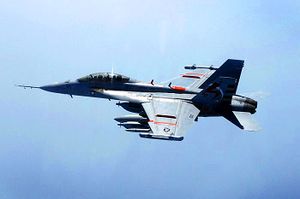PlaneSpottingWorld welcomes all new members! Please gives your ideas at the Terminal.
F/A-18E/F Super Hornet
| F/A-18E/F Super Hornet | |
|---|---|
| U.S. Navy F/A-18F from VFA-2 Bounty Hunters | |
| Type | Multirole fighter, strike fighter |
| Manufacturer | Boeing Integrated Defense Systems |
| Designed by | McDonnell Douglas |
| Maiden flight | 1995-11-29 |
| Introduced | 1999 |
| Primary user | United States Navy |
| Produced | 1995-present |
| Number built | 300[1] |
| Unit cost | US$57 million (F/A-18E) US$59 million (F/A-18F) |
| Developed from | F/A-18 Hornet |
| Variants | EA-18 Growler |
The Boeing F/A-18E/F Super Hornet is a carrier-based fighter/attack aircraft that entered service in 1999 with the United States Navy. It is a larger and more advanced development of the F/A-18C/D Hornet.
Contents
Background
The Super Hornet is a growth variant on the F/A-18C/D Hornet. The Super Hornet was ordered from McDonnell Douglas by the U.S. Navy in 1992, first flew in November 1995, made its first carrier landing in 1997 and entered service in 1999. Current versions include the F/A-18E single-seater and F/A-18F two-seater.
Despite the same general layout and systems, there are many differences from the original F/A-18 Hornet. The Super Hornet is informally referred to as the "Rhino" to distinguish it from earlier model "legacy" Hornets. The "Rhino" reference is important for safe aircraft carrier flight operations. For example; so that the arrestor cables are set correctly for the higher landing weight of a Super Hornet.
The early 1990s brought a number of problems for US naval aviation. The A-12 Avenger II program, intended to replace the obsolete A-6 Intruders and A-7 Corsair IIs, had run into serious problems and was cancelled. The Gulf War revealed that the US Navy's strike capability lagged behind that of the US Air Force in certain respects. With no clean-sheet program likely to produce results before about 2020, updating an existing design became an attractive approach. As an alternative to the A-12, McDonnell Douglas proposed the "Super Hornet" (or, initially, "Hornet II"), originally put forward in the 1980s to improve early F/A-18 models,[2] and serve as an alternate replacement for the A-6 Intruder which has a greater range / payload than the A-7 Corsair that the original Hornet was designed to replace.
At the same time, the Navy needed a fleet defense fighter to replace the canceled NATF, which was a proposed navalized variant of the F-22 Raptor. The Navy would also direct that this plane replace the aging F-14D Tomcat, essentially basing all naval combat jets on Hornet variants until the introduction of the F-35C Lightning II.[3] The Navy retained the F/A-18 designation to sell the program to Congress as a low-risk "derivative", though the Super Hornet is essentially a new aircraft with little more than an aerodynamic resemblance with previous Hornets.[4]
Initial production on the F/A-18E/F began in 1995. Flight testing started in 1996 and ending with sea trials and aerial refueling demonstrations in 1999. Testing involved 3,100 test flights covering 4,600 flight hours.[2] Low-rate production began in March 1997[1] with full production beginning in September 1997.[2]
The U.S. Navy's F-14 squadrons have converted to the Super Hornet, which is also taking on the missions of the retired A-6 Intruder, S-3 Viking, and KA-6D. An electronic warfare variant, the EA-18G Growler, will replace the aging EA-6B Prowler. The Navy calls this reduction in aircraft types a "neck-down". In the Vietnam War, the Super Hornet type missions were covered by no less than the A-1/A-4/A-7 (light attack), A-6 (medium attack), F-8/F-4 (fighter), RA-5C (recco), KA-3/KA-6 (tanker) and EA-6 (electronic warfare). It is anticipated that $1 billion in fleetwide annual savings will result from replacing other types with the Super Hornet.[5] Only the turboprop and rotor-wing aircraft roles will not be covered by the Hornet.
Design

Evolution
The design of the Super Hornet may have gone through a more extensive evolution than any other combat aircraft. The F-5 Freedom Fighter donated its basic wing platform, enlarged wing root extensions, and nose as the starting point for the Northrop YF-17 Cobra lightweight fighter.[6] The YF-17 was then sized up to produce the middle-weight F/A-18 multirole fighter, which roughly matched the Phantom in range/payload and missile armament. The Super Hornet is about 20% larger, 7,000 lb heavier empty, and 15,000 lb heavier at maximum weight than the original Hornet. Although the original YF-17 was about the same weight as the small F-5, the Super Hornet carries 33% more internal fuel, increasing mission range by 41% and endurance by 50% over the "Legacy" Hornet. The Super Hornet weighs 8% more empty than the original F-15C, which has itself been criticized for its large size. The Super Hornet is about 10,000 lb lighter than the F-14 Tomcat that was judged too expensive and large for a low-cost fighter, and even heavier than the original naval TFX specification that helped down the F-111B.
Airframe changes
The wing, center and aft fuselage, tail surfaces and power plants are entirely new. The Super Hornet has a 25% larger wing. The fuselage was stretched to carry more fuel and room for future avionics upgrades. An engine with 35% more power, the General Electric F414, was developed to power this larger, heavier aircraft. The aircraft can carry five 440 US gallon (1,700 liter) external fuel tanks for long-distance ferry flights or four tanks plus an Aerial Refueling Store (ARS), or "buddy store", which allows the Super Hornet to refuel other aircraft. The Super Hornet can return to an aircraft carrier with a larger load of unspent fuel and munitions. The term for this ability is known as "bringback". Bringback for the Super Hornet is in excess of 9,000 pounds.[7]
Other differences include angular intakes for the engines, a smaller radar cross section (RCS), two extra wing hardpoints for payload, and other aerodynamic changes. In the end, the Super Hornet shared little with earlier F/A-18s aft of the forward fuselage. The Super Hornet has 42% fewer structural parts than the original Hornet design.[8] Flight characteristics include being highly departure resistant through its flight envelope, high angle-of-attack and care free flying qualities for combat and ease of training.[9]
Avionics
While there is some similar cockpit items of the original Hornet, The Super Hornet features a touch-sensitive, up-front control display; a larger, liquid crystal multipurpose color display; and a new engine fuel display.[10] The digital flight-control system detects and corrects for battle damage.[9] Super Hornet production started with the APG-73 radar. The APG-79 AESA radar was introduced later (see the upgrade section below).
The ASQ-228 ATFLIR (Advanced Targeting FLIR), is the main electro-optical sensor and laser designator pod for the Super Hornet. Defensive systems include: AN/ALQ-214 Integrated Defensive Countermeasures system (IDECM), The IDECM system includes the ALE-47 countermeasures dispenser, the ALE-50 towed decoy and the AN/ALR-67(V)3 radar warning receiver and coordination of signal and frequency control emissions. Aircrew have the ability to use night vision goggles (NVG) for Super Hornet operations which means the aircraft interior and exterior lighting are NVG compatible.
Tanker role
The Super Hornet, unlike the previous Hornet, can be equipped with an aerial refueling system for the refueling of other aircraft,[11] filling the tactical airborne tanker role the Navy had lost with the retirement of the KA-6D tankers. The Hornet has a larger fuel payload capacity than the Tomcat, and is capable of flying the same high performance profiles as other strike aircraft. Critics such as Bob Kress, designer of the F-14 Tomcat, point out that the wing, however, is not as efficient as the subsonic KA-6, and that both Hornets and Super Hornets will be more dependent on inflight refueling than the longer range but retired Tomcat.
Upgrades
The APG-79 radar: New build aircraft will receive the APG-79. Earlier production Super Hornets will have their APG-73 replaced with the APG-79.[12] The new APG-79 AESA offers several advantages for the Super Hornet. The new radar gives the aircrew the ability to execute simultaneous air-to-air and air-to-ground attacks. The APG-79 also provides higher quality high-resolution ground mapping at long standoff ranges.[13] VFA-213 became "safe for flight" (independently fly and maintain the F/A-18F) on October 27, 2006 and is the first Super Hornet squadron to fly AESA-equipped Super Hornets.[14] AN/ALE-55 Fiber Optic Towed Decoy will replace the ALE-50.[15] Joint Helmet Mounted Cueing System provides multi-purpose aircrew situational awareness including high-off-bore-sight cueing of the AIM-9X Sidewinder missile. Shared Reconnaissance Pod (SHARP) Target Cuing System (TCS). SHARP is a high-resolution, digital tactical air reconnaissance system that features advanced day/night and all-weather capability.[16]
Missions performed
- Day/night strikes with precision-guided weapons
- Anti-air warfare
- Fighter escort
- Close air support
- Suppression of enemy air defense
- Maritime strike
- Reconnaissance
- Forward Air Control (Airborne) (FAC(A))
- Air-to-Air Refueling
Variants
EA-18G
The EA-18G Growler is an electronic warfare version of the F/A-18F Super Hornet, slated to begin production in 2008, with fleet deployment in 2009. The EA-18G will replace the U.S. Navy's EA-6B Prowler.
Combat service
The first unit to bring their F/A-18 Super Hornets to combat was VFA-115. On November 6, 2002, two F/A-18Es conducted a "Response Option" strike in support of Operation Southern Watch on two surface-to-air missile launchers at Al Kut and an air defense command and control bunker at Tallil air base. One of the pilots, Lieutenant John Turner dropped 2,000 lb JDAM bombs for the first time from the F/A-18E in wartime.
In Support of Operation Iraqi Freedom, VFA-14, VFA-41 and VFA-115 flew Close Air Support, strike, escort SEAD and aerial refueling. Two F/A-18Es from VFA-14 and two F/A-18Fs from VFA-41 were forward deployed to the USS Abraham Lincoln (CVN-72), the VFA-14 jets flew mostly as aerial refuelers and the VFA-41 jets as Forward Air Controllers.
On September 8, 2006, VFA-211 F/A-18F Super Hornet expended GBU-12 and GBU-38 bombs against Taliban fighters and Taliban fortifications west and northwest of Kandahar. This was the first time the unit was in combat with the Super Hornet.[17]
Units using the F/A-18E/F
- VFA-2 Bounty Hunters (F/A-18F)
- VFA-11 Red Rippers (F/A-18F)
- VFA-14 Tophatters (F/A-18E)
- VFA-15 Valions (Will transition to the F/A-18E in 2008)
- VFA-22 Fighting Redcocks (Will transfer F/A-18E's to VF-31 after their deployment, and then will receive new F/A-18F's)
- VFA-27 Royal Maces (F/A-18E)
- VFA-31 Tomcatters (have begun their transition to the F/A-18E in September 2006)
- VFA-32 Swordsmen (F/A-18F)
- VFA-41 Black Aces (F/A-18F)
- VFA-81 Sunliners (Will transition to the F/A-18E in 2008)
- VFA-102 Diamondbacks (F/A-18F)
- VFA-103 Jolly Rogers (F/A-18F)
- VFA-105 Gunslingers (F/A-18E)
- VFA-106 Gladiators (Fleet Replacement squadron, operates F/A-18C/D/E/F)
- VFA-115 Eagles (F/A-18E)
- VFA-122 Flying Eagles (Fleet Replacement squadron, operates F/A-18E/F)
- VFA-136 Nighthawks (started transition with VFA-106 as of September 2006)
- VFA-137 Kestrels (F/A-18E)
- VFA-143 Pukin' Dogs (F/A-18E)
- VFA-146 Blue Diamonds (Will transition to the F/A-18E in 2008)
- VFA-154 Black Knights (F/A-18F)
- VFA-211 Fighting Checkmates (F/A-18F)
- VFA-213 Black Lions (Started their transition to the F/A-18F in April 2006 and will be completed in September 2006)
- VX-9 Vampires (Air Test and Evaluation Squadron, operates F/A-18C/D/E/F, EA-6B, AV-8B, & AH-1)
Royal Australian Air Force
In December 2006, several Australian media sources reported that the Australian Government may make an order for 24 F/A-18Fs for the RAAF, to replace its aging F-111s,[18] due to concerns over possible delays to the F-35 Joint Strike Fighter (JSF) program. The order was confirmed on March 6, 2007.[3] RAAF crews will begin training in the USA in 2009 with squadrons to become fully operational in 2010.
The initial package offered to the RAAF will include:[19]
- 48 installed engines and six spare engines
- Equipped with the APG-79 AESA radar.
- Link 16 connectivity with the AN/USQ-140 Multifunctional Informational Distribution System (MIDS)
- LAU-127 Guided Missile Launchers
- AN/PVS-9 night vision goggles
- 12 Joint Mission Planning Systems
- AN/ALE-55 Fiber Optic Towed Decoys
Indian Air Force
The Indian Air Force has been offered the F/A-18E/F to replace their MiG-21s and MiG-23s. Boeing has also offered some technology transfer.[4]
Specifications
General characteristics
- Crew: 1 or 2 (F/A-18F)
- Length: 60 ft 1¼ in (18.31 m)
- Wingspan: 44 ft 8½ in (13.62 m)
- Height: 16 ft (4.88 m)
- Wing area: 500 ft² (46 m²)
- Empty weight: 30,564 lb (13,864 kg
- Basic weight: 31,500 lb (14,288 kg)
- Loaded weight: 47,000 lb (21,320 kg) (in fighter configuration)
- Max takeoff weight: 66,000 lb (29,900 kg)
- Powerplant: 2× General Electric F414-GE-400 turbofans
- Dry thrust: 14,000 lbf (62 kN) each
- Thrust with afterburner: 22,000 lbf (98 kN) each
- * Internal fuel capacity: F-18E 14,400 lb (6,530 kg),F-18F 13,550 lb (6,145 kg)
- External fuel capacity: 5× 480 gal tanks, totaling 16,380 lb (7,430 kg)
Performance
- Maximum speed: >Mach 1.8 (1,188 mph, 1,911 km/h) at high altitude
- Range: 681 mi (592 nm, 1,095 km) on hi-hi-hi interdiction mission with 4× 1,000 lb (450 kg) bombs, 2× AIM-9 Sidewinder missiles, and 2× drop tanks
- Combat radius: 150 nm (173 mi, 278 km) 135 min maritime air superiority mission with 6 AAMs and 3 drop tanks
- Service ceiling: >50,000 ft (15,000 m)
- Wing loading: 92.8 lb/ft² (453 kg/m²)
Armament
- Guns: 1× 20 mm (0.787 in) M61A1/A2 Vulcan cannon
- Hardpoints: 11 with a capacity of 17,750 lb (8,050 kg),with provisions to carry combinations of:
- Rockets: LAU-series multiple launchers for 70 mm (2.76 in) Hydra 70 air-to-surface unguided rockets
- Missiles:
- 2× AIM-9 Sidewinder on wingtips
- AIM-120 AMRAAM
- AGM-84 Harpoon
- AGM-88 HARM
- AGM-84E SLAM
- SLAM-ER
- AGM-65 Maverick missiles
- Bombs:
- AGM-154 Joint Standoff Weapon
- Joint Direct Attack Munition
- B61 nuclear freefall bomb
- Paveway LGBs
- Mk 80 series general-purpose bombs
- Mk-20 Rockeye II and CBU-series cluster bombs
Popular culture
- In 2000, Jane's Combat Simulations released a simulator based on the F/A-18E Super Hornet simply titled "Jane's F/A-18".
- The F/A-18F is the aircraft shot down in the film Behind Enemy Lines.
References
- ↑ Boeing delivers 300th Super Hornet
- ↑ 2.0 2.1 F/A-18 program mile stones
- ↑ Young, J., Anderson, R., Yurkovich, R., AIAA-98-4701, "A Description of the F/A-18E/F Design and Design Process", 7th AIAA/USAF/NASA/ISSMO Symposium on Multidisciplinary Analysis and Optimization, St. Louis, Missouri, 2-4 September 1998. (F-18E intended to replace A-6 and F-14D)
- ↑ Jenkins, Dennis R. (2000). F/A-18 Hornet: A Navy Success Story. New York: McGraw-Hill. ISBN 0-07-134696-1.
- ↑ The F/A-18E/F Super Hornet: Tomorrow's Air Power Today (PPT). National Defense Industrial Association. Retrieved on 2006-12-12.
- ↑ Aviation Week article on YF-17 design, 1974
- ↑ Navy League,June 2002, Ready On Arrival: Super Hornet Joins The Fleet
- ↑ F/A-18E/F Super Hornet - maritime strike attack aircraft
- ↑ 9.0 9.1 F/A-18E/F Super Hornet Boeing page
- ↑ FAS.org F/A-18 page
- ↑ "Boeing Super Hornet Demonstrates Aerial Refueling Capability" Boeing Global Strike Systems, April 14, 1999
- ↑ Boeing Frontiers: F/A-18E/F Block II upgrades add to Super Hornet's potent arsenal (June 2005)
- ↑ Defense Industry Daily: New APG-79 AESA Radars for Super Hornets (April 26, 2005)
- ↑ Boeing F/A-18E/F Block 2 Super Hornets Flying at Naval Air Station Oceana
- ↑ Globalsecurity.org AN/ALE-55 Fiber Optic Towed Decoy
- ↑ Raytheon Awarded Navy Contract to Increase SHARP System Capability Oct 4,2006
- ↑ Strikes Continue; ISAF Air Component Commander Visits Big E
- ↑ Defence Industry Daily"Australia to Buy 24 Super Hornets As Interim Gap-Filler to JSF?" (December 27, 2006).
- ↑ Reuters-Pentagon's Defense Security Cooperation Agency informs congress of possible foreign military sale February 6, 2007
External links
- F/A-18E/F Super Hornet on Boeing.com
- F/A-18E/F Super Hornet on NorthropGrumman.com
- F/A-18E/F Super Hornet on Aerospaceweb.org
- Hornet vs. Super Hornet comparison
- List of USN Strike Fighter Squadrons
- Aerial Refueling Systems Network home page
- 'USS Enterprise aircraft deliver lethal sting of bombs to enemy in Afghanistan' Stars and Stripes October 13, 2006
Related content
Related development
Comparable aircraft
Designation sequence
| F/A-18 | - F-20 - F-21 - F-22 | |
| F/A-18E/F |
Related lists
- List of active United States military aircraft
- List of fighter aircraft
- List of military aircraft of the United States
See also
Fighters: XP-67 · FH · F2H · XF-85 · XF-88 · F3H · F-101 · F-110 · F-4 · F-15 · F/A-18 · CF-188 · YF-23 · F/A-18E/F
Attack: AH · AV-8 · F-15E · A-12 - Trainers: T-45
Transports: C-9 · KC-10 · YC-15 · C-17
Helicopters: XHJH · XH-20 · XHCH · XHRH · AH-64
Drones: TD2D · KDH - Experimental: XV-1 · X-36 · Bird of Prey - Spacecraft: Mercury · Gemini
Lists relating to aviation | |
|---|---|
| General | Timeline of aviation · Aircraft · Aircraft manufacturers · Aircraft engines · Aircraft engine manufacturers · Airports · Airlines |
| Military | Air forces · Aircraft weapons · Missiles · Unmanned aerial vehicles (UAVs) · Experimental aircraft |
| Notable incidents and accidents | Military aviation · Airliners · General aviation · Famous aviation-related deaths |
| Records | Flight airspeed record · Flight distance record · Flight altitude record · Flight endurance record · Most produced aircraft |
cs:F/A-18E/F nl:F/A-18E/F Super Hornet no:F-18 pl:Boeing F/A-18E/F Super Hornet




